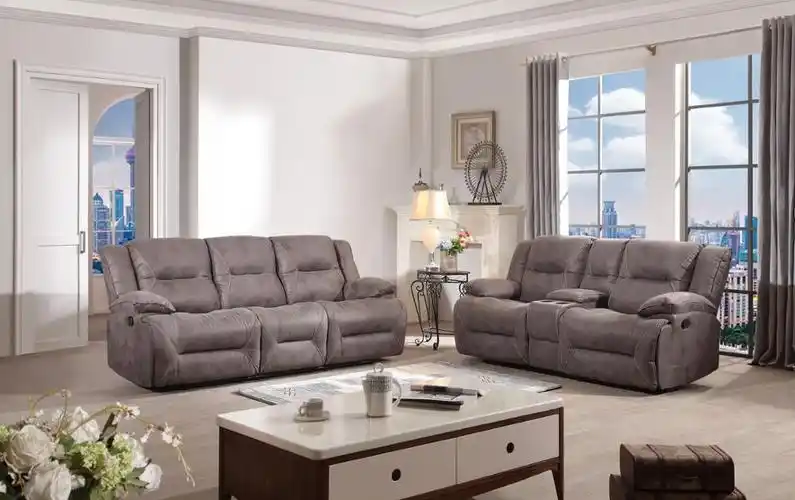Abstract
The sofa is not only a place to rest, but also a silent spokesperson for home style and quality of life. Material selection is directly related to comfort experience, visual beauty, service life and daily maintenance costs. This article will deeply analyze the characteristics, advantages, limitations and applicable scenarios of six core sofa materials – genuine leather and imitation leather, suede fabric and wool fabric, wooden frame and metal support, and introduce authoritative agency data and research to help you clear the fog, invest accurately, and choose the home partner that best meets your needs.

1. Genuine leather: the inheritor of luxurious texture, the dual promise of durability and style
Top-grade genuine leather sofas are selected from high-quality animal leather embryos such as cowhide, and they present unique textures and natural breath through multiple rigorous processes. Its excellent ductility and breathability bring unparalleled skin-friendly experience. Data from the American Leather Association (Leather Research Laboratory) show that the tear resistance of full-grain leather far exceeds that of artificial materials. The natural protective layer formed on its surface has excellent stain resistance and easy cleaning properties, and it only needs to be wiped gently regularly to be renewed. As time goes by, the leather will form a charming “patina” with a warm and shiny luster, and its value increases with use. The top British furniture brand James Harrison emphasizes: “A high-quality leather sofa is a family treasure that can be passed down for three generations.” Of course, its high price and the maintenance requirements of avoiding sharp objects and staying away from direct sunlight should also be taken into consideration.
2.Imitation leather (artificial leather): cost-effective simulation art, a wise choice of pragmatism
Modern imitation leather technology uses polyurethane (PU) or polyvinyl chloride (PVC) as the base material, and highly reproduces the appearance and touch of leather through exquisite embossing technology. Its biggest advantage lies in its significant price affinity and color and style diversity. The International Home Furnishings Association reports that high-quality PU imitation leather can withstand more than 100,000 abrasions (Martindale test) and is generally waterproof, making it highly resistant to daily splashes. However, be wary of cracks on the surface and poor air permeability that can easily occur in low-priced and low-quality products. When purchasing, pay attention to thickness, back base fabric quality and environmental certification (such as OEKO-TEX® Standard 100). The OEKO-TEX® certification official website provides reliable product inquiries.
3.Suede fabric: warm touch and color magic, creating a lazy style
Suede fabrics (such as velvet and corduroy) use their unique velvet cutting process to create a luster that changes under forward and reverse light and a soft wrapping feeling like clouds. Its excellent warmth makes it a favorite for autumn and winter homes. In terms of color expression, suede material has excellent absorption of dyes, which can present a deep, rich and dramatic visual effect. Authoritative home media Better Homes & Gardens praised: “Velvet sofas are the finishing touch to enhance the retro luxury of the space.” However, its velvet structure is easy to hide dust and debris, and is also sensitive to liquid stains. It needs to be equipped with special brushes for regular maintenance and use professional cleaners to deal with stains.
4.Wool fabrics (wool/blends): natural and luxurious temperature guardians
Wool material is derived from nature and has excellenttemperature regulation ability-warm in winter and cool in summer. Its fiber structure can absorb and release moisture, bringing a dry and comfortable sitting feeling. The natural curl of wool fiber gives the sofa excellentrebound and compression resistance, and it is not easy to collapse and deform after long-term use. The Woolmark Company has confirmed that wool has natural flame retardant and low static electricity properties, which improves home safety. As shown on The Woolmark Company’s official website, high-end wool blended sofas take into account both performance and design. Its maintenance is relatively professional, and dry cleaning is usually recommended to avoid shrinkage and deformation. Subsequent maintenance investment needs to be considered before investment.
5.Wooden frame: the solid skeleton of the sofa, the foundation of durability and environmental protection
As the “invisible backbone” of the sofa, the quality of the wooden frame directly determines the stability and service life of the overall structure. Hard wood such as birch, beech or oak is the first choice due to its high density and strength. Forest Stewardship Council (FSC) certified wood not only guarantees the sustainability of the source, but also means stricter process standards, which effectively prevents moisture and moth. The American Home Furnishings Alliance clearly pointed out: “The mortise and tenon structure combined with high-quality hardwood frame is the golden rule for the durability of high-end sofas.” When purchasing, you can pay attention to the details of the frame connection process and related environmental certification logos (such as FSC, PEFC). The FSC Certification Query Platform provides reliable traceability.
6.Metal support (legs/structure): the finishing touch of modern simplicity, need to be prevented
Metal elements (usually stainless steel, aluminum alloy or iron art) are often seen in sofa legs or decorative structural supports, injecting a neat modern feel or exquisite industrial style into the space. Metal has strong load-bearing capacity and high plasticity. However, its surface coating integrity is crucial-poor quality electroplating is prone to oxidation rust or coating peeling due to moisture or friction. Choosing metal parts that have been treated with anti-oxidation (such as powder coating), are thick enough and have rounded edges can effectively prolong the beauty and safety, and avoid scratching the floor or family members.
Summary:
The choice of sofa material is a journey of rationality and sensibility. From the timelessness of genuine leather to the practicality and colorfulness of imitation leather, from the gentleness and laziness of suede to the natural luxury of wool fabric, to the silent support of wooden frames and the modern embellishment of metal elements – each material speaks a different language of life.
The data and certifications of authoritative organizations (such as LRL, IHFA, FSC, Woolmark) provide us with a reliable scale that goes beyond subjective feelings. The material that wins in the end must be the one that can perfectly balance your desire for comfortable touch, your imagination of aesthetic style, your requirements for durability and practicality, and your budget for maintenance costs. Let the well-thought-out material selection create the ideal seat in your home that carries laughter and rest.
